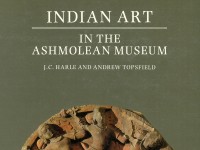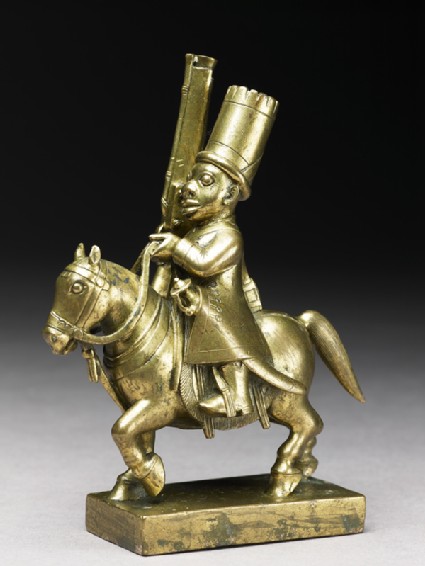Indian Art in the Ashmolean Museum
A catalogue of the Ashmolean’s collection of Indian art by J. C. Harle and Andrew Topsfield (published Oxford, 1987).

Publications online: 143 objects
- Reference URL
Actions
Toy soldier with horse and musket
-
Literature notes
These small brass figures are most unusual in Indian sculpture for their skilful charming representation, bordering on humorous caricature, of contemporary military types. The seven mounted figures in the Ashmolean’s group comprise a mustachioed officer on an elephant, a similarly mustachioed lancer on a frisky horse, a matchlock-man on a capering camel, a negro carabineer, a rocket-man with two tall rocket-launchers, a cavalier with a curved sword and a horse and rider in a quilted cap and coats. There are also four footsoldiers, smaller in scale and less elaborately finished, which may be of a later date. These comprise a European infantryman in a tricorne hat, a native sepoy of the East India Company’s Madras Army and two Indian spearmen. Other groups of Vizagapatam figures are in the Madras Museum, the Madras School of Art, the Victoria and Albert Museum, the National Army Museum, the Royal collection at Sandringham and private collections. With their large heads, squat bodies, enormous weapons and upright bearing, they “graphically illustrate the whole gamut of military swagger in man and beast” (Birdwood).
Their traditional attribution to Vizagapatam (Vishakhapatnam) on India’s eastern coast is supposed by the unique inscriptions on the Ashmolean’s elephant figure, giving the date 1795 on its forehead and the name Vizagapatam in Roman capitals on its rump. A Company factory (or trading post) had been established there in the late 17th century, and in 1794 the British took over control from the debt-ridden local Raja. The administrative officials who then moved in may have been among the first European collectors of the brass soldiers, which were possibly first manufactured for a local ruler, albeit after European models, for the style and characterization of the figures, as well as their solid rectangular bases, are quite un-Indian.
Thurston records two traditions describing their origin at Peddapuram, a town about 80 miles south of Vizagapatam and at that time the capital of a large zamīndārī estate. According to one story, the local Raja, Timma Razu (d. 1797), had the figures made on the advice of his astrologer for presentation to Brahmins in order to avert his threatened death. Another version had his astrologer suggesting that for the Raja to hold a review of the toy army each day, without blood being shed, would have the same desirable effect. The names of the artist and the two craftsmen concerned were recorded as Adimurti and the brothers Virachandracharlu and Viracharlu respectively, and the whole army of figures was said to have been sold off at the beginning of the 19th century. However this may be, some evidence for the popularity of such toy armies with the Deccani minor nobility of the time is provided by a painting in the State Museum, Hyderabad, in which a Raja sits listening to music on a garden terrace while a procession of toy soldiers parades along the path in front of him (Zebrowski, loc. cit.). Such model armies must have been cheaper and more manageable than the real thing.
The production of toy-soldiers was itself a European fashion dating from the Renaissance period. Armies made of precious metals were especially popular at the Frnech court in the 17th century, but these were all later melted down and, even in base metals, very few early examples survive. In England solid toy-soldiers (“solids”, as opposed to “flats” or two-dimensional examples) appear to have been unknown until after the Napoleonic wars, and it is therefore likely that the Vizagapatam soldiers are the oldest large group of “solids” to have survived. Unlike Western examples, they are not manufactured uniformly by piece-moulding, but are individually modelled and cast by the cire perdue process, thus allowing a greater variety of detail and expression. The question of their evident debt to a European source remains an interesting problem. It is perhaps likely that the prototypes were modelled not by Thurston’s shadowy “Ādimūrti”, a Sanskrit (Brahmin?) name meaning “primordial image”, but by a talented European amateur artist, with an eye for caricature, in the English or French military service. -
Details
- Associated place
-
Asia › India › south India › Andhra Pradesh › Vishakhapatnam (place of creation)
- Date
- 1790 - 1795
- Associated people
-
Timma Jagapati IV, Raja of Peddapar (active late 18th century - died 1796) (commissioner)
- Material and technique
- brass
- Dimensions
- 12.4 x 9.6 x 3.8 cm max. (height x width x depth)
- Material index
-
processed material › metal › alloy › copper alloy › brass
- Technique index
- Object type index
- No. of items
- 1
- Credit line
- Presented by A.H. Prior, 1969.
- Accession no.
- EA1969.44.d
-
Further reading
Harle, J. C., and Andrew Topsfield, Indian Art in the Ashmolean Museum (Oxford: Ashmolean Museum, 1987), no. 74 on pp. 65-67, illus. p. 66
Digby, S., and J. C. Harle, Toy Soldiers and Ceremonial in Post-Mughal India (Oxford: Ashmolean Museum, 1982), pp. 5-7, illus. p. 4 & pl.1
Thurston, E., V. Asari, and W. S. Hadaway, Illustrations of Metal Work in Brass and Copper: Mostly South Indian (Madras: Superintendent Government Press, 1913)
Location
Objects are sometimes moved to a different location. Our object location data is usually updated on a monthly basis. Contact the Jameel Study Centre if you are planning to visit the museum to see a particular object on display, or would like to arrange an appointment to see an object in our reserve collections.
Galleries
Publications online
-

Indian Art in the Ashmolean Museum
These small brass figures are most unusual in Indian sculpture for their skilful charming representation, bordering on humorous caricature, of contemporary military types. The seven mounted figures in the Ashmolean’s group comprise a mustachioed officer on an elephant, a similarly mustachioed lancer on a frisky horse, a matchlock-man on a capering camel, a negro carabineer, a rocket-man with two tall rocket-launchers, a cavalier with a curved sword and a horse and rider in a quilted cap and coats. There are also four footsoldiers, smaller in scale and less elaborately finished, which may be of a later date. These comprise a European infantryman in a tricorne hat, a native sepoy of the East India Company’s Madras Army and two Indian spearmen. Other groups of Vizagapatam figures are in the Madras Museum, the Madras School of Art, the Victoria and Albert Museum, the National Army Museum, the Royal collection at Sandringham and private collections. With their large heads, squat bodies, enormous weapons and upright bearing, they “graphically illustrate the whole gamut of military swagger in man and beast” (Birdwood).
Their traditional attribution to Vizagapatam (Vishakhapatnam) on India’s eastern coast is supposed by the unique inscriptions on the Ashmolean’s elephant figure, giving the date 1795 on its forehead and the name Vizagapatam in Roman capitals on its rump. A Company factory (or trading post) had been established there in the late 17th century, and in 1794 the British took over control from the debt-ridden local Raja. The administrative officials who then moved in may have been among the first European collectors of the brass soldiers, which were possibly first manufactured for a local ruler, albeit after European models, for the style and characterization of the figures, as well as their solid rectangular bases, are quite un-Indian.
Thurston records two traditions describing their origin at Peddapuram, a town about 80 miles south of Vizagapatam and at that time the capital of a large zamīndārī estate. According to one story, the local Raja, Timma Razu (d. 1797), had the figures made on the advice of his astrologer for presentation to Brahmins in order to avert his threatened death. Another version had his astrologer suggesting that for the Raja to hold a review of the toy army each day, without blood being shed, would have the same desirable effect. The names of the artist and the two craftsmen concerned were recorded as Adimurti and the brothers Virachandracharlu and Viracharlu respectively, and the whole army of figures was said to have been sold off at the beginning of the 19th century. However this may be, some evidence for the popularity of such toy armies with the Deccani minor nobility of the time is provided by a painting in the State Museum, Hyderabad, in which a Raja sits listening to music on a garden terrace while a procession of toy soldiers parades along the path in front of him (Zebrowski, loc. cit.). Such model armies must have been cheaper and more manageable than the real thing.
The production of toy-soldiers was itself a European fashion dating from the Renaissance period. Armies made of precious metals were especially popular at the Frnech court in the 17th century, but these were all later melted down and, even in base metals, very few early examples survive. In England solid toy-soldiers (“solids”, as opposed to “flats” or two-dimensional examples) appear to have been unknown until after the Napoleonic wars, and it is therefore likely that the Vizagapatam soldiers are the oldest large group of “solids” to have survived. Unlike Western examples, they are not manufactured uniformly by piece-moulding, but are individually modelled and cast by the cire perdue process, thus allowing a greater variety of detail and expression. The question of their evident debt to a European source remains an interesting problem. It is perhaps likely that the prototypes were modelled not by Thurston’s shadowy “Ādimūrti”, a Sanskrit (Brahmin?) name meaning “primordial image”, but by a talented European amateur artist, with an eye for caricature, in the English or French military service.
Notice
Object information may not accurately reflect the actual contents of the original publication, since our online objects contain current information held in our collections database. Click on 'buy this publication' to purchase printed versions of our online publications, where available, or contact the Jameel Study Centre to arrange access to books on our collections that are now out of print.
© 2013 University of Oxford - Ashmolean Museum















